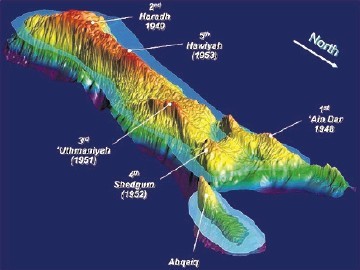
The oil price was near its lowest in more than a decade, cash reserves were being depleted, emerging markets were in turmoil and Saudi Arabia was beginning to panic.
“It was a very scary moment,” said Khalid Alsweilem, former head of investment at the Saudi Arabian Monetary Agency, the country’s central bank. “And luckily at that point, oil prices started going up. Not by design, by good luck.”
That was 1998, and now Saudi Arabia’s fortunes threaten to turn again. This time, luck might not be enough as the government tries to protect the wealth of a nation whose economy has swelled by five times since then. The bastion of conservative Sunni Islam also is paying for an expanding role in regional conflicts in the face of a resurgent Iran and Islamic State extremists who have bombed Saudi mosques.
Economists are predicting a budget deficit of as much as 20 percent of gross domestic product and the International Monetary Fund forecasts a first Saudi current-account deficit in more than a decade. Reserves at the central bank tumbled 10 percent from a year ago, or by more than $70 billion.
As a result, bets on the devaluation of the riyal are surging. The Tadawul All Share Index lost 18 percent in the past three months and dragged stocks down across the Gulf region. The benchmark’s moving averages made a so-called death cross on Aug. 18, a sign to some investors that more losses are ahead.Patient Saudis
The Saudis have “played a waiting game,” Robert Burgess, Deutsche Bank AG’s chief economist for emerging markets in Europe, the Middle East and Africa, said from London. “The budget for next year is going to be a very important milestone that the markets are going to be focusing on quite intently.”
With oil prices down by more than half over the past 12 months to below $50, Saudi Arabia faces many of the same financial problems it did in 1998.
The difference is the sheer cost of maintaining the state as an employment machine and guarantor of the riches that Saudis have become accustomed to since the last squeeze. Subsidized gasoline costs 16 cents per liter and while there’s the religious levy called zakat, there is no personal income tax in the nation of 30 million people.
“The Saudi government can’t continue to be the employer of first resort, it can’t continue to drive economic growth through the big infrastructure projects and it can’t keep lavishing on subsidies and social spending,” said Farouk Soussa, chief Middle East economist for Citigroup Inc. in London.Taking Action
That’s not to suggest Saudi Arabia is headed for the kind of spending cuts and tax increases more familiar to austerity- hit Europeans. The government, for instance, could first freeze the expansion of two mosques in Mecca or tax wealthy landowners, Jamal Khashoggi, a former media adviser to Saudi Prince Turki al-Faisal, said by phone from Riyadh.
“There’s a long list of things that Saudi officials can do before touching the livelihood of ordinary Saudis,” said Khashoggi. “Yes, it’s a difficult time and maybe it could have been much better if we did what we’re doing today a couple of years ago when the price of oil was in the $100s.”
During those good times, King Abdullah, who ruled from 2005 until his death in January, increased social spending as the Arab Spring uprisings toppled leaders elsewhere.
It’s also not like Saudi Arabia has no control over its destiny. Oil rebounded after 1998 – the price of crude advanced in 11 of the 16 calendar years since then – not least because the Saudis used their clout as the de facto leader of the Organization of Petroleum Exporting Countries, or OPEC.What Crisis?
The country has declined to cut production and lift prices over the past year to gain market share from the shale industry in the U.S. and other producers with higher expenses, even if that’s come at a cost to its finances. Saudi Arabia still has $664 billion of net foreign assets, equal to almost 90 percent of the economy, and little debt.
“I wouldn’t say there’s any kind of crisis or even a crisis on the near horizon,” said David Butter, associate fellow at Chatham House in London. “They’re in the oil business. They’ve had it pretty good for quite a long time and that’s not typical.”
Even so, the IMF recommends that Saudi Arabia control its growing wage bill, make changes to government subsidies for fuel and electricity and bring in more non-oil revenue through taxes. The country’s breakeven oil price – the point at which it can balance its budget – is about $100, said Soussa at Citigroup.
Fuel subsidies alone will cost Saudi Arabia as much as 195 billion riyals ($52 billion) this year, or 8 percent of GDP, Riyadh-based Samba Financial Group said in an Aug. 18 report. Central bank Governor Fahad al-Mubarak already has called for a review of price subsidies.
A new economic council headed by Deputy Crown Prince Mohammed bin Salman could help make the changes if it can move quickly, said Alsweilem, the former investment chief who is now a fellow at Harvard University’s Belfer Center.
While less per capita than in smaller energy-rich Gulf states Qatar and the United Arab Emirates, the relative wealth of Saudi Arabia means the government might need to tread carefully. Any adjustment will be “jarring,” said Soussa.
“These are things that are absolutely politically explosive,” he said. “You’ve gotten accustomed to a certain lifestyle and that lifestyle is far in excess in terms of luxury that was prevailing in 1998.”
Recommended for you
